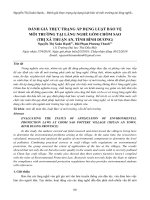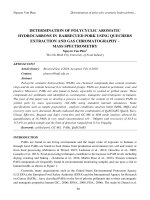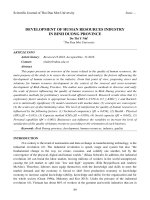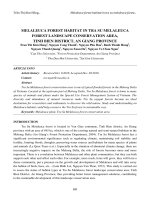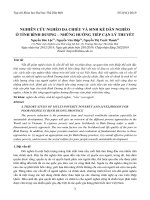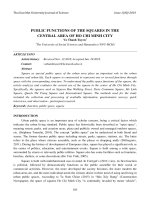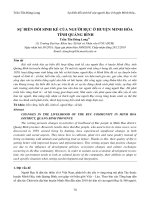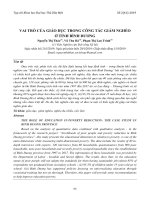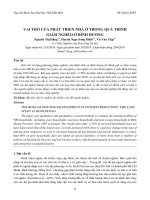DEVELOPMENT OF HUMAN RESOURCES INDUSTRYIN BINH DUONG PROVINCE DO THI y NHI, tạp CHÍ đại học THỦ dầu một, số 1(40),2019,TR 89 102
Bạn đang xem bản rút gọn của tài liệu. Xem và tải ngay bản đầy đủ của tài liệu tại đây (314.28 KB, 14 trang )
Scientific Journal of Thu Dau Mot University
Issue ...
DEVELOPMENT OF HUMAN RESOURCES INDUSTRY
IN BINH DUONG PROVINCE
Do Thi Y Nhi1
1
Thu Dau Mot University
ARTICLE INFO
Article history:
Received 12.2018, Accepted Dec. 31.2018.
Contact:
Abstract
This paper presents an overview of the issues related to the quality of human resources, the
main purpose of the study is to assess the current situation and analyze the factors influencing the
development of human resources in the industry. From that point of view, proposing views and
solutions for human resource development in the context of the renewal and socio-economic
development of Binh Duong Province. The author uses qualitative methods to discover and unify
the scale of factors influencing the quality of human resources in Binh Duong province and the
quantitative methods for preliminary research and official research. Research results show that (1)
exploratory factor analysis is appropriate because KMO is 0.676 in 0.5 ≤ KMO ≤ 1 and Barlett's
test is statistically significant; (2) model consistent with market data; (3) concepts are convergent;
(4) the scales are of discriminating value. The level of satisfaction for quality of human resources is
influenced by the following factors: (1) Technical competency (1 = 0.654); (2) Health - Physical
(HP) (2 = 0.165); (3) Capacity method (CM) (3 = 0.050); (4) Social capacity (5 = 0.042); (5)
Personal capability (4 = 0.005). Businesses can influence the variables to increase the level of
satisfaction of the quality of human resources according to the orientation of each business.
Keywords: Binh Duong province, development, human resources, industry, quality
INTRODUCTION
21st century is the trend of automation and data exchange in manufacturing technology, is the
industrial revolution 4.0. The industrial revolution is speed, range and system but also "the
fundamental change in the way we create, consume, and solidify one another, led by the
convergence of the physical, digital and human worlds." (Klaus Schwab). In addition, the industrial
revolution 4.0 can break the labor market, leaving millions of workers in the world unemployed,
causing the job market to split into "low and high" segments (Erik Brynjolfsson and Andrew
McAfee). Therefore, laborers must equip themselves with the knowledge and skills to meet the
market demand and the economy is forced to shift from production economy to knowledge
economy to increase capital knowledge (ability, knowledge and skills) for the organization and for
the whole society (Grant 1996a, Mahoney and Kor 2015). Under the pressure of the industrial
revolution 4.0, Vietnam has about 86% of workers in the garment and textile industries that are in
89
Development of Human resources Industry…
Do Thi Y Nhi
danger of losing their jobs and industries such as agriculture, accounting, assembling and repairing
equipment. Facing the challenge of technical qualifications (ILO, 2017), comparing Vietnam's labor
productivity with other countries in SEAN, the quality of human resources in Vietnam is only 3.39 /
10 and Vietnam's competitiveness is ranked 73/133. Households are ranked; In terms of quantity,
about 54.61 million workers aged 15 and over have not received vocational training, about 11.73
million trained workers have diplomas or certificates (WB, 2017).
As a locality of Vietnam, Binh Duong Province has a rapid socio-economic development and
has a high rate of urbanization. Since 1992, Binh Duong has implemented a policy of attracting
high-level human resources to meet the development needs of the province. By 2017, the province
has attracted more than 400 people with postgraduate qualifications (Socio-economic development
strategy for the period 2011-2020 and the plan for socio-economic development). This is only a
team to create stable human resources, high quality in the initial period, the difference in supply
does not meet the needs of the province. With the vision "Binh Duong become and become a major
industrial center of the country, the problem of human resources will be shortage and a great barrier
to the process of global integration. Especially human resources meet the common standards of the
market to promote the development in a stable and sustainable way.
THEORETICAL BASIS
Human capital theory (Human captial, HC)
According to Schultz (1961), HC consists of the knowledge, skills and abilities of those who
work in the organization. Becker identifies HC as knowledge, ideas, skills and personal health.
Botins and CTG (1999, p391) suggest that HC is the human element in the organization; The
combination of intelligence, skill and expertise has made the organization stand out. This shows that
the HC elements of the organization are capable of learning, change, innovation and creativity that
will affect the development of the organization. This shows that HC is a key element of production
across the economy, as HC accumulation improves labor productivity; Increase profits for capital
and make growth more sustainable (De la Fuente and Doménech (2000, 2006)).
Human resources, quality of human resources
The International Labor Organization (ILO) holds that human resource is a collective of labor
potentials of a country that has been prepared to a certain degree, capable of being mobilized in the
process of socio-economic development assembly. Considering from a developmental point of
view, the human resource is the total population of a given age that is capable of participating in
labor, expressed on two sides: First, the number is the total number of persons in degrees the age of
the employee working according to the regulations of the state and the working time can be
mobilized from them; Second, quality is the health and professional qualification, knowledge and
skill of the workers. Therefore, the human resource in the manufacturing sector is the direct labor
force, characterized by the size (quantity), quality and structure of human resources involved in the
production and business process of the foundation economy.
"The quality of human resources is considered in terms of health, education level, professional
qualification and capacity" (Tran Xuan Cau and Mai Quoc Chanh, 2009). In the industrial revolution
90
Scientific Journal of Thu Dau Mot University
Issue ...
4.0, the human resource is evaluated based on four types of competencies: (1) technical competence
including all knowledge and skills; (2) methodological capacity covering all skills and abilities to
solve common problems and decision-making; (3) social competence includes all skills and abilities
as well as the attitude of cooperation and communication with others; (4) Personal competencies
include the social values, motivations and attitudes of an individual (Shahd & Hampe, 2015).
Human resource development
The United Nations Development Program (UNDP) has developed a human development
concept for each country's development criteria to measure and rank human development (HDI).
The HDI reflects a country's average level of basic human capacity. Hamlin and Stewart define the
main goals for developing human resources: (1) Improving the efficiency and effectiveness of
individual/group performance. Improve the efficiency and effectiveness of the business; (2) develop
knowledge and capacity; (3) Strengthening the potential and personal development of workers
(Helmrich, 2015).
In Vietnam, the issue of human interest has long been in the Temple of Literature with its
inscriptions on the first scientific plate in 1442 to the XIIth Congress. The Party also affirmed:
"Promoting factors human beings in all spheres of social life; Focusing on the ethics, personality,
lifestyle, intelligence and work capacity; build a healthy cultural environment ". This shows that the
development of a country's human resources is a change in the quantity and quality of human
resources in terms of physical, mental, intellectual, and spiritual well-being.
RESEARCH METHODOLOGY AND DATA
Research Methods
The paper uses qualitative research methods and quantitative research. Qualitative research
aims to develop criteria and quality of human resources in industrial production. This scale is
developed in the form of unilateral five steps from level 1 to level 5. Quantitative research was
conducted through the design stages of the research sample, collecting information and analysis of
data by SPSS 20.0 software to confirm the factors as well as values and reliability of the scale,
factors affecting the quality of human resources in the industry.
Information and data systems
Secondary information: Secondary information for the study was collected from sources
published in prestigious journals; National statistical yearbook and Binh Duong, The General
library of Ho Chi Minh city.
Primary information: Based on the results of group discussions in the qualitative research, the
survey was designed as a research data collection tool. The author has determined the independent
scale of five factors, 28 variables affect the quality of human resources.
The data collection process was conducted through the Industrial Park Management Board,
who sent the survey to enterprises in the industrial park in Binh Duong. Samples were selected by
convenient sampling method. In this study, the authors performed in 105 enterprises with 230
samples. However, after cleaning the data, only 210 samples were available.
91
Development of Human resources Industry…
Do Thi Y Nhi
RESEARCH RESULTS
Recommended research model
On the basis of domestic and foreign research, field surveys and integration with the context
of industrialization and modernization, international integration and the high demands of the
industrial revolution 4.0. The author suggests a general research model as follows:
Symbol
Influence
factor
HP
Health - physical
TC
Technical capability
Hypothesis
Dependent Factor
H01
H02
PC
Personal capability
H03
CM
Capability method
H04
SC
Social competence
H05
Quality of
human
resources
HR
Figure 1. The proposed research model
(Source: Author of the proposal)
This research was conducted with the expectation about the relationship between the factors
affecting human resource quality.
No
Variable name
Explain
Expected
1
HP
Health – physical
+
2
TC
Technical capability
+
3
PC
Personal capacity
+
4
CM
+
5
SM
Capacity method
Social competence
+
Situation of human resource development in Binh Duong industry
Binh Duong is a province in the South East, which is considered as a focal point of Central
and Highland provinces. The pace of socio-economic development and urbanization is very high.
According to “Statistical Yearbook 2017, Binh Duong Statistical Office” and “Binh Duong 20 years
of formation and development”, In 2010, the urban population was 512,908 people, accounting for
31.66%. The rural population was 1,107,022 people, accounting for 68.34%. However, by 2017, the
92
Scientific Journal of Thu Dau Mot University
Issue ...
urban population was 1,577,876 people, accounting for 76.19%. The rural population is 493,075
people, accounting for 23.81%.
In terms of population growth, the average annual population growth rate in Binh Duong is
about 3.39%, with a natural growth rate of 1 to 1.14%. Population quality: The total population in
the working age of Binh Duong province in 2017 is about 1,291,508, accounting for 62.2% of the
population, 779,443 people working outside the working age, accounting for 37.4% of the
population. number. This indicates that Binh Duong is still a golden age.
In terms of gross domestic product (GDP), in the 1997-2000 period an average increase of
14.1% / year. This is a period of relatively high growth rate compared to the whole country and
other provinces and cities in the southern key economic region. In the period of 2001-2005, GDP in
the province at 1994 constant prices had an average growth rate of 15.3% per year. In the period of
2006-2010, the GDP at 1994 constant prices had an average growth rate of 14.1% / year. In the
period of 2011-2015, the GDP at 1994 constant prices has an average growth rate of 13.1% per
annum, GDP per capita at current prices in 2015 reached VND72.7 million per person, an increase
of 2.4 2010.
About industrial: The industrial production index (IIP) is the percentage of industrial
production produced in the current period with the volume of industrial production in the original
period (same period last year and the next period). Provincial IIP reached 110.4% in 2012; 111.7%;
2014 is 109.2%, up by 9.3% in comparison with 2014; 201.2% decrease 0.1% compared to 2015;
201.8% increase in 2017 compared to 2016. Industrial development of Binh Duong has contributed
greatly in the process of increasing the IIP of the country.
About service: Total retail sales of goods and services in Binh Duong in 1997 reached 3,042
billion VND in 2017 reached 132,234 billion (43.5 times increase compared to 1997), export
turnover in 1997 reached 363 USD to USD 28,533.7 million by 2017 (an increase of 786.1 times
compared to 1997).
About education: Since 1997, Binh Duong has been recognized as a national standard for
illiteracy eradication and universal primary education. By 2005, the province reaches the national
standard for junior secondary education. In the 2011-2015 period, the education and training sector
has implemented the 2011-2020 education development strategy and the comprehensive reform of
the basic education and training associated with the implementation of the planning and human
development program. As of May 17, Binh Duong province has 8 universities, six colleges, 17
professional secondary schools, 46 vocational training centers and 50 foreign language and
computing centers. The movement of good teaching, good learning in teachers and students is
invested to meet the needs of teaching and learning.
On health and health care: As of 31/12/2017, there are 136 establishments, of which 23 are
hospitals, 1 nursing and rehabilitation hospital, 19 regional polyclinics, 91 communes, wards, offices,
factories. The number of beds under the relevant health service in 2017 is 4,997 for the hospital, 100 for
the nursing home, 212 for the general clinic and 455 for the health clinic, offices, factories. In terms of
medical personnel in 2017, there are 933 doctors, 964 doctors, and 1306 nurses. The average life
expectancy of people in the province in 2014 is 75.4 years to 2017, reaching 75.9 years. This showed
that the health of Binh Duong people has improved not only in quantity but also in quality.
93
Development of Human resources Industry…
Do Thi Y Nhi
Labor market: Number of enterprises operating in Binh Duong in 2010 is 7,368; in 2012 is 8,600
enterprises; 10,177 businesses in 2013; 2014: 11,101 enterprises and 12,069 enterprises in 2015. As of
31/12/2014, the number of enterprises operating in Binh Duong is 12,069 and accounting for 17.19% of
the South East. The number of laborers aged 15 and over in Binh Duong Province in 2010 was 1,014.6
thousand, accounting for 60.9% of the total population; In 2012: 1,147.2 thousand people, accounting for
64.8% of the total population; In 2013: 1,197.7 thousand people, accounting for 64.9% of the total
population; In 2014: 1,268.7 thousand people, accounting for 66.1% of the total population and 2015:
1,270.8 thousand people, making up 63.4% of the total population.
About human characteristics: By 2017, the percentage of the literate population aged 15 and
over in the province will be over 97%; literacy rates between urban areas (97.6%) and rural areas
(95.5%); Between men (97.8%) and women (96.8%) are not much different. Labor force has
professional and technical qualifications compared to the total labor force is low. In term of average
level from university to university, the number of qualified professional in 2015 is about 40,662,
accounting for 3.29%; In 2016, about 38,409 will be in the rate of 3.1% and 39,421 in 2017,
accounting for 3.18%.
Results of qualitative research
The author conducted in-depth interviews, with the aim of unifying the theoretical
background, the conceptual framework and the proposed research model, the draft scale. The scale
is developed in the form of a five-level Liker scale, from level 1 to level 5. Specifically: (1) The
scale of technical competence (TC) includes knowledge and professional skills, with 6 observation
variables from TC1 - TC6; (2) Health - psychometric scale (HP), with 5 observation variables from
HP1 - HP5; (3) The scale of the methodological capacity (CM) includes the skills and ability to
solve common problems and decision making, with 8 observation variables from CM1 - CM6; (4)
Scale of personal capacity (PC) includes values, motives and attitudes of individuals; (5) Scale of
social capacity, including issues related to the culture of employees, with 4 observations from SC1 SC4. And the results of group discussions designed a survey on the quality of human resources of
enterprises in Binh Duong's industrial zones.
Results of quantitative research
Characteristics of survey samples
Out of the total 210 samples were surveyed in 105 firms. In terms of the surveyed subjects,
there were 5 members of the board of directors, accounting for 2.4%; 40 samples were heads of
department, accounting for 19%; 102 samples were deputy department heads, accounting for 48.6%
and 63 samples were heads of production, accounting for 30%. In terms of administrative units,
there are 50 samples of enterprises in Thu Dau Mot city, accounting for 23.26%; 15 samples of
enterprises in Ben Cat town, accounting for 6.98%; 26 samples of enterprises in the area of Tan
Uyen town, accounting for 12.09%; 54 enterprises in Thuan An town, accounting for 25.12%; 53
samples in enterprises in Di An town, accounting for 24.56%; 4 samples of enterprises in Phu Giao;
4 samples in enterprises in Bau Bang area, accounting for 1.86% and 5 samples in enterprises in
Bac Tan Uyen area, accounting for 2.33%. In terms of type of enterprises, there are 26 enterprises in
the state sector, accounting for 12.09%; 122 non-state enterprises, accounting for 57.74% and 67
enterprises belonging to the foreign investment sector, accounting for 31.16%.
94
Scientific Journal of Thu Dau Mot University
Issue ...
Describe the scores of enterprises on the criteria groups
Meaning of each mean value for the distance scale - calculated by distance value: (Maximum
value - Minimum value) / n = (5-1) / 5 = 0.8.
Health-physical
Table 1. Statistics of health- physical factors
The rating of the business
Content rated
Average
Max
Min
Standard
deviation
Sample
size
Classification
3.02
5
2
0.966
210
Average
The speed of processing work is
flexible and skillful
3.14
5
2
0.986
210
Average
Ability to fight the illness
3.10
5
2
0.969
210
Average
Control the pressure on the job
3.16
5
2
0.984
210
Average
Overtime ability based on health
3.19
5
2
0.974
210
Average
Health meets the
required by the job
minimum
Source: Survey and calculation by the author
Through the assessment of the business can see the criteria of health - physical strength is
only moderate and limited in height, weight, stature, agility, activity, flexibility task; the ability to
cope with illness and ability to work overtime on the basis of health. This is a very important issue
in the development of human resources.
Technical capacity
Technical capacity is assessed mainly through: basic knowledge of social nature; Professional
and technical qualifications; Higher academic ability; Capacity for innovation and creativity;
Capacity in foreign languages; Capacity in information technology.
Table 2. Statistics describing the assessment of technical competence
The rating of the business
Content rated
Basic knowledge of social nature
Professional and technical
qualifications
Higher academic ability
Capacity of innovation and
creativity
Competence in foreign languages
Capacity in information
technology
Average
Max
Min
Standard
deviation
Sample
size
Classification
3.52
5
2
0.796
210
Good
3.49
5
2
0.734
210
Good
3.60
5
2
0.826
210
Good
3.34
5
2
0.607
210
Average
2.57
5
2
0.676
210
Weak
3.20
5
2
0.609
210
Average
Source: Survey and calculation by the author
The survey results show that the technical capacity of human resources in the new units is
only medium to high level. Especially the capacity in foreign languages and IT qualifications is
limited compared to the requirements. Criteria for technical capacity in recent years have been
95
Development of Human resources Industry…
Do Thi Y Nhi
improved. The proportion of workers trained at colleges and universities in the industry is on the
upward trend, labor quality is improved one step. Therefore, the province needs to have solutions to
improve these areas.
Capacity of personality
The personality of high quality human resources is assessed through the following main
contents: Consciousness of discipline, observance of regulations; Responsibility for work; Strict
working style; The spirit of progress in work; Self-control.
Table 3. Statistics describing the scores of individual criteria
Content rated
Basic knowledge of social nature
Professional and technical
qualifications
Higher academic ability
Capacity of innovation and
creativity
Competence in foreign
languages
The rating of the business
Standard
Average
Max Min
deviation
3.67
5
2
0.752
Sample
size
210
Classification
Good
3.48
5
2
0.672
210
Good
3.30
5
2
0.671
210
Average
3.45
5
2
0.726
210
Good
3.19
5
2
0.612
210
Average
Source: Survey and calculation by the author
From the results of the survey of enterprises in Binh Duong province, the personality of
human resource was only average to high. In particular, industrial working style and responsibility
for work are only average.
Methodological capabilities
In the past years, the dynamics and adaptability of Vietnamese workers in general and labor
in the manufacturing sector in Binh Duong have been improving, particularly in the young and
Long-term, regular-trained workers.
Table 4. Statistics describing the assessment of methodological competence
The rating of the business
Content rated
Sample
size
Classificati
on
Average
Max
Min
Standard
deviation
Skills to apply knowledge in the work
3.59
5
2
0.701
210
Good
Ability to adapt to the working
environment
3.55
5
2
0.692
210
Good
Teamwork skill
3.21
5
2
0.548
210
Average
Communication skills (negotiation,
negotiation)
3.23
5
2
0.615
210
Average
Ability to work independently
3.46
5
2
0.611
210
Good
Organizational skills
3.28
5
2
0.518
210
Average
Planning skills
3.49
5
2
0.628
210
Good
3.25
5
2
0.585
210
Average
Decision-making skills
Source: Survey and calculation by the author
96
Scientific Journal of Thu Dau Mot University
Issue ...
From the results of the survey, the methodological capacity of the human resource is from
average moderate to good, in which group work skills, independent working skills, communication
skills and decision-making skills are only average rating.
Social competence
Table 5. Statistics describing scores on social competence
The rating of the business
Content rated
Average
Max
Min
Standard
deviation
Sample
size
Classification
Love of work, passion for work
3.59
5
2
0.701
210
Average
Attachment with the organization
3.55
5
2
0.692
210
Good
The spirit of cooperation in the
work
3.21
5
2
0.548
210
Average
Cultural behavioral skills at work
3.23
5
2
0.615
210
Good
Source: Survey and calculation by the author
The above table shows that enterprises assess the social competence of human resource from
medium to high level. It can be seen that the factor of attachment to the organization, the spirit of
cooperation in the work and the cultural behavior in the job is appreciated by businesses.
Evaluating the qualification in the industry of the province
Valuation and reliability of 5 scales
Test condition for discovery factor analysis (EFA)
Examining the relationship between 28 observed variables in the whole by testing KMO and
Bartlett's with the support of SPSS statistical software showed that the variables in the whole were
correlated (Mean of significance sig = 0.000 <0.05) with a coefficient of KMO = 0.676 (0.5
Distinguishing values and convergence values of scales
By EFA, Principal components with Varimax and Criteria for determining the number of
factors are paired with at least 1 eigenvalue factor.
Table 6. Exploration Factor Analysis (EFA)
Factor
Survey variables
1
TC1. Basic knowledge of social nature
0,941
TC2.Professional and technical qualifications
0,927
TC3.Higher academic ability
0,914
TC4.Capacity of innovation and creativity
0,859
TC5. Competence in foreign languages
0,857
TC6.Capacity in information technology
0,856
2
0,917
HP1. Health meets the minimum required by
97
3
4
5
Development of Human resources Industry…
Do Thi Y Nhi
the job
HP2. The speed of processing work is flexible
and skillful
0,898
HP3. Ability to fight the illness
0,878
HP4. Control the pressure on the job
0,821
HP5. Overtime ability based on health
0,776
MC1. Skills to apply knowledge in the work
0,958
MC2. Ability to adapt to the working
environment
0,949
MC3. Teamwork skill
0,954
MC4. Communication
negotiation)
skills
(negotiation,
0,945
MC5. Ability to work independently
0,928
MC6. Organizational skills
0,952
MC7. Planning skills
0,924
MC8. Decision-making skills
0,913
CP1. Basic knowledge of social nature
0,954
CP2. Professional and technical qualifications
CP3. Higher academic ability
0,937
CP4. Capacity of innovation and creativity
0,915
CP5. Competence in foreign languages
0,907
SC1. Love of work, passion for work
0,929
SC2. Attachment with the organization
0,911
SC3. The spirit of cooperation in the work
0,926
SC4. Cultural behavioral skills at work
0,741
Eigenvalue
6,257
4,112
3,309
2,575
2,036
Variance is explained by the analytical factor
(%)
28,443
18,69
1
15,040
11,706
9,257
Cumulative (%)
28,443
47,134
62,174
73,880
83,137
Source: Author calculates according to data collected from quantitative research
Of the 28 observed variables, the EFA was reduced to five groups of factors, with the
observed variables in each factor corresponding to the number and composition of each scale as the
initial assumption measurement scale. Thus, the 5 scales with 28 observed variables have been
constructed according to the hypothesis of satisfying the requirement of discriminative value.
Convergence Valuation of Scales: The obtained EFA results show that the scales meet the
convergence value with the total variance equal to 83,137> 50% and the factorial weight of the 28
observed variables all> 0.5.
Verify the reliability of each scale using the Cronbach Alpha confidence factor: Based
on the results of the survey of 105 enterprises operating in Binh Duong province, using SPSS
software, the Cronbach Alpha reliability coefficient for the 5 scales is relatively high (Cronbach
Alpha is larger than 0, 7). The coefficient of correlation in each scale is> 0.5. This shows that in all
98
Scientific Journal of Thu Dau Mot University
Issue ...
five scales, the observed variables in each scale are strongly correlated. Thus, all 5 scales with 28
observation variables ensure reliability.
Estimate and test the fit of the model by regression analysis: For estimating the
parameters and testing the suitability of the proposed model, the multiple regression method was
used based on 105 enterprise satisfaction survey data in 28 observational variables of 5 structural
components into the model. Regression results show that:
Experiment independent variables: Reliability, serviceability, level of empathy, level of
responsiveness, tangible means were statistically significant and Sig <0.05 showed that the
variables included were significant with a significance level of 95% or higher and the impact on the
dependent variable - The level of satisfaction in the quality of human resources of high quality. This
means that the independent variables affect the dependent variable.
Checking the general suitability of the model: The coefficient of multiplication of R2 (R
square) in this model is 0.715 (corresponding to 71.5%) showing the fit of the model to the overall.
This indicates the suitability of the model is 71.5% or, in other words, 71.5%. The variation of the
dependent variable is generally explained by the independent variables in the model. Adjusted R
Square value is 0.798. All variables had mean Sig value <0.05, with a relatively high correlation
coefficient (R = 0.717) showing the close relationship between the variables independent of the
dependent variable. Thus, the regression function can be used (in other words, the fit of the
regression function).
Multi-collinear testing: In the case of a multi-collinear model, the independent variables are
closely related and it gives the model very similar information and it is difficult to isolate the effect
of individual variables. The interpretation of the regression results in comparison with reality needs
to evaluate and measure the phenomenon of multi-collinearity. To measure multi-collinearity
between independent variables, we used the Variance inflation factor (VIF). The covariance-VIF
corresponds to the degree of tolerance - Tolerance (= 1- Ri2). In fact, it is the inverse of the
acceptability, ie for the variable Xi, VIF = 1 / (1 - Ri2). When the tolerance is small then the large
VIF, the rule is when the VIF exceeds 2, which is the sign of multi-collinearity. According to the
values in the following table, the multipliers of the variance - VIF are less than two, so the multicollinearity of the independent variables does not affect the regression model.
Analysis of ANOVA: Analysis of ANOVA shows that the F = 30.546, Sig value = 0.000,
indicates that the regression model constructed is consistent with the collected data set and is usable.
Autocorrelation testing: If the model has a chain correlation or autocorrelation, the test will
be invalidated, so that the model parameters are statistically significant. The Durbin-Watson test
results for d = 1,970. This value is within the allowable range of 215 observations and the
independent variable is 5 (1,802
CONCLUSION
Theoretical model consists of 5 components with 28 observation variables. Through the
regression analysis (below), the results of the model estimation by OLS method are as follows:
99
Development of Human resources Industry…
Do Thi Y Nhi
Table 7. Results of regression analysis of factors affecting the quality of human resources
Regression
coefficient (j )
0,373
0,654
Value t
- X2 : Health – Physical (HP)
0,165
1.530
- X3 : Capacity method (CM)
0,050
0.509
- X4 : Personal capacity (PC)
0,005
11.502
- X5 : Social competence (SC)
0,042
1.706
Analysis variables
Block factor
- X1: Technical capability (TC)
Durbin -Watson
0,988
0.872
Sig
Multi-Column VIF
.000
.000
.000
1.096
.000
1.235
.000
.000
1.299
1.032
1.049
1.970
R-square
F test
Sig
0,715
30.546
0,000
Source: Author calculates according to data collected from quantitative research
We have a regression model:
Y = 0,373 + 0,654 X1 +0,165 X2 + 0,050 X3 + 0,005 X4 + 0,042 X5
This is a linear multiple regression with a blocking coefficient of 0.373 and a sufficiently
reliable and appropriate linear regression model to provide a basis for analyzing, evaluating and
estimating the level of satisfaction with quality. Human resources in the manufacturing sector.
According to this regression equation, there are five linear relationship coefficients with satisfaction
level of human resources with significant significance of <0.05. All have positive effects that reflect
proportional to the level of evaluation.
Through the multivariate regression analysis, it was found that the constructed model was
consistent with the data obtained and the initial results showed that the above-mentioned
components had significance level of <0.05. Statistical significance with reliability is 95%.
Therefore, they significantly affect the level of satisfaction with the quality of human resources.
Thus, the level of satisfaction for quality of human resources is influenced by the following factors:
(1) Technical Competency (1 = 0.654); (2) Health - Physical (HP) (2 = 0.165); (3) Capacity
method (CM) (3 = 0.050); (4) Social Capacity (5 = 0.042); (5) Personal Capability (4 = 0.005),
factors are arranged in order from important to less important. According to the distance value
(maximum value – minimum value)/n = (5-1)/5=0,8; enterprises with specific criteria of quality of
human resources are as follows:
In terms of technical capacity, only from average to good, especially the capacity of
foreign languages is still weak and the level of IT is limited compared to the
requirements. This is the criterion for the most important quality of high quality human
resources in the industry. Criteria for technical competence in recent years have
improved. The rate of trained workers at college level and above in the industry of the
province tends to increase, the quality of labor is enhanced one step.
100
Scientific Journal of Thu Dau Mot University
Issue ...
About health - fitness is only at average level and quite near. However, it is still low
compared to other countries in the weight height index, so it faces many difficulties in
using and operating modern and large-sized machinery and equipment, working in an
unfavorable environment. such as on high or deep, hard working conditions, great
psychological burden.
The method capacity is only from average to good, in which teamwork skills,
independent working skills, communication skills, decision-making skills are only
assessed at average level.
Social capacity reaches the level from average to good. It can be seen that the factor of
attachment to the organization, the spirit of cooperation in work and cultural behavior
skills in the work are evaluated by businesses.
Personal ability only reaches the level from medium to quite. In particular, the industrial
labor style, responsibility for work is only evaluated at an average level.
REFERENCES
Armstrong M, Taylor S (2014). Armstrong's Handbook of Human Resource Management Practice.
Borjas, G. J. (2005). The labor market impact of high-skill immigration.
Chu Van Cap (2012). Developing high quality human resources for sustainable development in
Vietnam, Journal of Communists, 9 (839), 54-58.
Geneva: World economic forum. Available at />Grant, R.M. (1996a). Toward a knowlegde – based theory of the film. Strategic Management
Journal, 17(2), 109 – 22.
Helmrich K (2015). Digital Enterprise - Fertigungs- und Prozessindustrie auf dem Weg zu Industrie
4.0. Handelsblatt Journal - Sonderveröffentlichung zum Thema
International Labour Office (ILO). (2017a). How to facilitate the recognition of skill of migrant
workers: Guide for police makers, employment policy department (Geneva).
Le Thi Tuoi (2016). Demand for Human Resources of Socio-professional Organizations and
Requirements for Higher Education Institutes in Vietnam. Journal of Education sex, No. 385.
/>Luong Viet Hai (2003). Influence of scientific, technical and technological advances to the research
and development of human and human resources in the early years of the 21st century (Topic)
Nguyen Minh Hac (2001). Research on people and resources into industrialization and
modernization. Hanoi: National Political Publishing House.
Nguyen Ngoc Khuong, Nguyen Hoang Phong (2016). The Situation and Solutions for the
Development of High Quality Human Resources for Socio-Economic Development in Vinh
Long Province 2016-2020. sex, number 375, period 1.
/>101
Development of Human resources Industry…
Do Thi Y Nhi
Nguyen Tien Dung and Nguyen Phan Thu Hang (2011). Development of high quality human
resources in Ho Chi Minh City. Journal of Science and Technology Development, 14 (1), 101105.
Nguyen Van Khanh (2012). Vietnam's human resources, history, current status and prospects.
Hanoi: National Political Publishing House.
Nick Bontis (1999). Managing organizational knowledge by diagnosing intellectual capital: framing
and advancing the state of the field. Vol 18. Nos 5/6/7/8, 1999
Pham Minh Hac (1991 - 1995). The Vietnamese people - the objective and motive force of socioeconomic development (Topic).
Pham Ngoc Hoa (2016). Some solutions to improve the quality of training laborers to meet the
social needs in Dong Thap province. Journal of Education, No. 374 />Shahd M, Hampe K (2015). Industrie 4.0 erstmals unter den Top-Themen des Jahres.
Accessed 16 Dec 2015.
Spath D, Ganschar O, Gerlach S, Hämmerle M, Krause T, Schlund S (2013). Produktionsarbeit der
Zukunft - Industrie 4.0. Stuttgart: Fraunhofer Verlag.
Tran Xuan Cau, Mai Quoc Chanh (2009). Curriculum of Human Resource Economics. Hanoi :
National Economics University Publishing House.
Vo Xuan Tien (2013). Improving the quality of human resource training for enterprises. Journal of
Science and Technology, University of Da Nang, 6 (67), 151-155.
Vu Hy Chuong (2002). Assessing, forecasting prospects and basic solutions to create resources for
industrialization and modernization (Topic).
W. Schultz (1961). The American Economic Review. Vol LI, No1. Accessed March 1961
World and Vietnam (2016). Outstanding Achievements in Economic Development over 30 Years of
change
World Economic Forum Global Agenda council on competitiveness (2017). Competitive cities and
their connections to global value chains, white paper.
102

